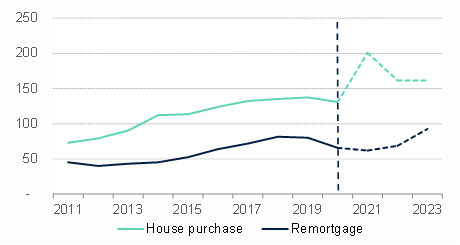2021 set to be a record year for mortgage lending since financial crisis
UK Finance has today (13 December) published its housing and mortgage market forecasts for 2022 and 2023 together with projections for 2021 full year numbers in the mortgage lending ad housing markets.
Key figures from publication:
- UK Finance estimates that gross lending overall will peak this year at £316bn, up 31 per cent on 2020, then moderate to £281bn in 2022, before increasing to £313bn in 2023 (Chart 1).
- Total house purchase transactions (including cash purchases) will reach 1.5 million in 2021, some 47 per cent higher than 2020 and, in fact, the highest number since before the Global Financial Crisis.
- The main driver of lending in 2021 will be for house purchase, (£200bn, up 53 per cent on 2020), whereas homeowner remortgaging activity will be slightly down on last year at £62bn.
- Buy-to-let activity has followed a similar path to the residential sector, with purchase activity increasing to £18bn, up 83 per cent on 2020.
- While the 2022 and 2023 gross lending figures will be reductions on the 2021 peak, notably they are higher than the 2020 and 2019 figures and represent a return to more stable levels of activity.
James Tatch, Principal, Data and Research at UK Finance, said:
“2021 has been a bumper year for mortgage lending amid the stamp duty holiday and homeworkers moving from cities. The outlook for the housing and mortgage markets over the next two years is for a return to more stable, balanced picture following the upheavals of the last two years.
“While risks remain, both to new lending and ongoing affordability, the market looks to be emerging from the pandemic in a better place than previously anticipated, supported by a much-improved wider economic outlook.”
Market overview: a return to moderate growth
The housing market will inevitably soften in 2022 compared to this year, as the demand stimulus from the stamp duty holiday will no longer be a factor boosting house purchases. However, other Covid-19-triggered behavioural changes, most significantly the resurgence in home-mover numbers following a decade of stagnation, are likely to provide some continued impetus.
UK Finance’s recent Q3 Household Finance Review showed that home-mover activity has been reinvigorated after a decade of stagnation by changing attitudes to working from home, particularly as remote working is now embedded in many businesses’ longer-term policies.
The lack of a daily commute for many existing homeowners who were previously constrained by relatively low levels of equity with which to “staircase up” the housing ladder within the city they work means they can now consider different locations where their existing equity will go further.
Meanwhile, refinancing activity will pick up modestly next year but accelerate somewhat in 2023, as higher volumes of fixed rate deals, including five-year deals taken out in 2017, are set to end and the loans become eligible for refinancing.
In general, the outlook for both lending and ongoing mortgage affordability is much improved compared to forecasts made a year ago.
Chart 1: Gross mortgage lending, £ billions
Kindly shared by UK Finance
Main photo courtesy of Pixabay



















